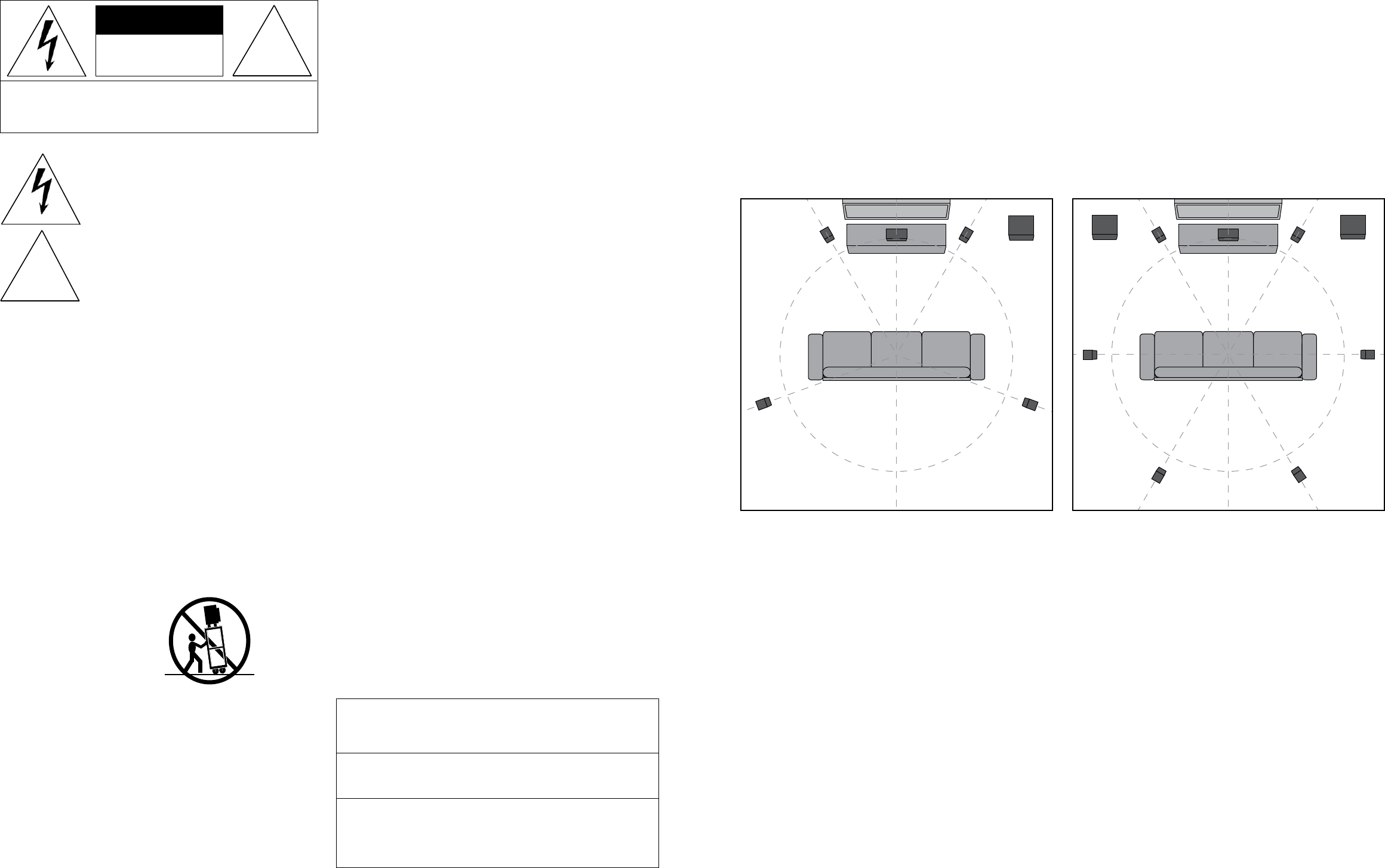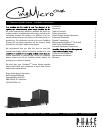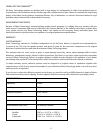
1. Read Instructions - All the safety and operating
instructions should be read before the appliance is
operated.
2. Retain Instructions - The safety and operating
instructions should be retained for future reference.
3. Heed Warnings - All warnings on the appliance and
in the operating instructions should be adhered to.
4. Follow Instructions - All operating and other
instructions should be followed.
5. Water and Moisture - The appliance should not
be used near water - for example, near a bathtub,
washbowl, kitchen sink, laundry tub, in a wet basement,
or near a swimming pool, etc.
6. Carts and Stands - The appliance should be used
only with a cart or stand that is recommended by the
manufacturer.
PORTABLE CART WARNING
7. Wall or Ceiling Mounting - The appliance should be
mounted to a wall or ceiling only as recommended by
the manufacturer.
8. Ventilation - The appliance should be situated so
that its location or position does not interfere with its
proper ventilation. For example, the appliance should not
be situated on a bed, sofa, rug, or similar surface that
may block the ventilation openings; or placed in a built-
in installation, such as a bookcase or cabinet that may
impede the ow of air through the ventilation openings.
9. Heat - The appliance should be situated away
SAFETY INSTRUCTIONS
from heat sources such as radiators, stoves, or other
appliances that produce heat.
10. Power Source - The appliance should be
connected to a power supply only of the type described
in the operating instructions or as marked on the
appliance.
11. Power Cord Protection - Power supply cords
should be routed so that they are not likely to be
walked on or pinched by items placed up or against
them, paying particular attention to cords at plugs,
convenience receptacles, and the point where they exit
from the appliance.
12. Cleaning - The appliance should be cleaned only
as recommended by the manufacturer.
13. Nonuse Periods - The power cord of the
appliance should be unplugged from the outlet when
left unused for a long period of time.
14. Object and Liquid Entry - Care should be taken
so that neither objects fall nor liquids spill into the inside
of the appliance.
15. Damage Requiring Service - The application
should be serviced by qualied service personnel when:
a. the power supply cord or the plug has been
damaged,
b. objects have fallen onto or liquid has been spilled
into the appliance,
c. the appliance has been exposed to rain,
d. the appliance does not appear to operate normally
or exhibits a marked change in performance, or
e. the appliance has been dropped or the cabinet
damaged.
16. Servicing - The user should not attempt to service
the appliance beyond those means described in the
operating instructions. All other servicing should be
referred to qualied service personnel.
17. Grounding or Polarization - Precautions should
be taken so that the grounding or polarization means of
an appliance is not defeated.
!
Explanation of Graphical Symbols
The lightning ash with arrowhead symbol, within
an equilateral triangle, is intended to alert you to the
presence of un-insulated “dangerous voltage: within the
product’s enclosure that may be o sucient magnitude
to constitute a risk of electric shock to persons.
The exclamation point within an equilateral triangle
is intended to alert you to the presence of important
operating and maintenance (servicing) instructions in the
literature accompanying the appliance.
CAUTION: To reduce the risk of electric shock, do not remove cover (or
back). No user-serviceable parts inside. Refer servicing to qualied service
personnel.
CAUTION
RISK OF ELECTRIC
SHOCK
!
APPLICABLE FOR USA, CANADA OR WHERE
APPROVED FOR USAGE
CAUTION: TO PREVENT ELECTRIC SHOCK, MATCH WIDE
BLADE PLUG TO WIDE SLOT, INSERT FULLY.
ATTENTION: POUR EVITER LES CHOCS ELECTRIQUES,
INTRODUIRE LA LAME LA PLUS LARGE DE LA FICHE
DANS LA BORNE CORRESPONDANTE DE LA PRESE ET
POUSSER JUSQU AU FOND.
HOME THEATER SPEAKER PLACEMENT
Today’s digital multi-channel home theater technology has elevated the art of “surround sound” to reproduce the
movie theater experience in your own home. Speaker requirements and placement are important when reproducing
these multi-media eects.
Two front speakers (left and right), two surround speakers (left and right), a center-channel speaker, and a subwoofer
dene the minimum arrangement for multi-channel systems such as Dolby® Pro Logic, DTS™, and Dolby Digital.
The CineMicro
One
was designed as a matched system to give you the most realistic seamless experience possible.
Placement of speakers in your room will impact the nal listening experience. To position your speakers, there are
some general guidelines that take room size, shape, and xtures and furnishings into account. Use the following
illustrations as a general guide for speaker placement in a typical home theater system.
3
LF
RF
LS RS
SUB
C
LF
RF
LS
RS
LR RR
SUB
C
SUB
5.1 HOME THEATER SYSTEM
In a 5.1 home theater system, the center channel (C) should be
placed at 0º directly below or above the video screen, the left front
(LF) and right front (RF) speakers should be placed at 30º from the
listening area, and the left and right surrounds (LS and RS) should
be placed at 110º. All ve speakers should be placed at or near ear
level.
7.2 HOME THEATER SYSTEM
In a 7.2 home theater system, the center channel (C) should be
placed at 0º directly below or above the video screen, the left front
(LF) and right front (RF) speakers should be placed at 30º from the
listening area, and the left and right surrounds (LS and RS) should
be placed at 90º. The left rear (LR) and right rear (RR) speakers (sold
separately) should be placed at 150º. All seven speakers should be
placed at or near ear level.
Front speakers should be placed 6-8 feet apart (or on the sides or your screen if your screen is wider) to fully
separate the left and right channels. Whether placed on speaker stands or on shelves, your speakers should be at
or slightly above ear level.
Rear surround speakers also should be placed at or slightly above your listening position for the best reproduction
of surround-sound eects. Ideally, they should be facing into your favorite listening position from either side of the
room.
Center speaker placement should be, if possible, directly on top of or under your TV monitor or projection TV
screen. Center speakers should be placed in a horizontal orientation, directly below (or above) the center of your
video screen. This correctly positions the critical sound track information (usually dialogue) that lmmakers direct to
the center channel. Phase Technology center speakers are magnetically shielded so that they will not interfere with
any TV’s.







